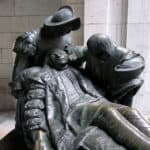Loyola, Spain: Saint Ignatius of Loyola
About Saint Ignatius of Loyola:
To fully appreciate the shrine of Saint Ignatius of Loyola and the influence of Saint Iganatius you must first know the story of St. Ignatius.
He was born as Inigo de Loyola in 1491 in Azpeitia in the Basque province of Guipuzcoa in northern Spain. He was the youngest of thirteen children. At the age of sixteen years he was sent to serve as a page to Juan Velazquez, the treasurer of the kingdom of Castile. As a member of the Velazquez household, he was frequently at court and developed a taste for all it presented.
He was much addicted to gambling, very contentious, and not above engaging in swordplay on occasion. In fact, in a dispute between the Loyolas and another family, Ignatius and his brother (plus some relatives) ambushed some clerics one night who were members of that other family. Ignatius had to flee the town. When finally brought to justice he claimed clerical immunity using the defense that he had received the tonsure as a boy, and was therefore exempt from civil prosecution. The defense was suspicious because Ignatius had for years gone about in the dress of a fighting man, wearing a coat of mail and breastplate, and carrying a sword and other sorts of arms—certainly not the garb normally worn by a cleric. The case dragged on for weeks, but the Loyolas were apparently powerful. Probably through the influence of those higher up, the case against Ignatius was dropped.
 An officer by the age of 30, he found himself defending the fortress of the town of Pamplona against the French, who claimed the territory as their own. During the battle a cannon ball struck Ignatius, wounding one leg and breaking the other as portrayed in the statue at the Shrine (photo to right). Because they admired his courage, the French soldiers carried him back to recuperate at his home, the castle of Loyola, rather than prison. His leg was set but did not heal. Ignatius grew worse and was told by the doctors that he should prepare for death.
An officer by the age of 30, he found himself defending the fortress of the town of Pamplona against the French, who claimed the territory as their own. During the battle a cannon ball struck Ignatius, wounding one leg and breaking the other as portrayed in the statue at the Shrine (photo to right). Because they admired his courage, the French soldiers carried him back to recuperate at his home, the castle of Loyola, rather than prison. His leg was set but did not heal. Ignatius grew worse and was told by the doctors that he should prepare for death.
During his recuperation, he was bored and asked for some romance novels to pass the time. Luckily there were none in the castle of Loyola, but there was a copy of the Life of Christ and a book on the Saints. Desperate for something to do he began to read them. The more he read, the more he considered the exploits of the Saints worth imitating. This was the beginning of his conversion.
On the feast of Saints Peter and Paul he took an unexpected turn for the better. He was healed but all his life he walked with a limp.
Saint Ignatius is well-known for his Spiritual Exercises and for being the founder of the Jesuit Order. We celebrate his Feast Day on July 31.
About the Basilica in Loyola:
A Shrine was built around the tower house where he lived and there is also a magnificent Basilica located here in Northeastern Spain. Those who are unaware of it are often surprised to see such a huge and beautiful Basilica located in this rather sparsely populated area.
Next to the Basilica is a spirituality center, that hosts retreats, seminars, meetings, congresses and every type of spiritual and pastoral activities, overseen by a community of the Handmaids of Christ the King. It contains several chapels, housing for participants as well as a restaurant.
Note: you will find his tomb at the Church of the Gesu in Rome.
Traveling to Loyola:
The nearest cities are either Bilbao or San Sebastian. Although there is an airport in San Sebastian it has quite limited service whereas the Bilbao airport has flights to several European destinations. There are trains from Madrid to Bilbao (about 4-5 hours) as well as to San Sebastian. From either city you would need to take a bus to Loyola.
Address: 20730 Loiola, Guipúzcoa, País Vasco, Spain
GPS coordinates: 43° 10′ 27.3936” N, 2° 16′ 57.9216” W
Tel: +34 943 02 50 00
e-mail: eneko@sjloyola.org
Click here for the official website of the Sanctuary of Saint Ignatius of Loyola.

How can I participate on the retreats , seminars or other related activities ?
Suggest you contact the shrine with the contact information on this page. Click English at top of page, then click “Retreat House”